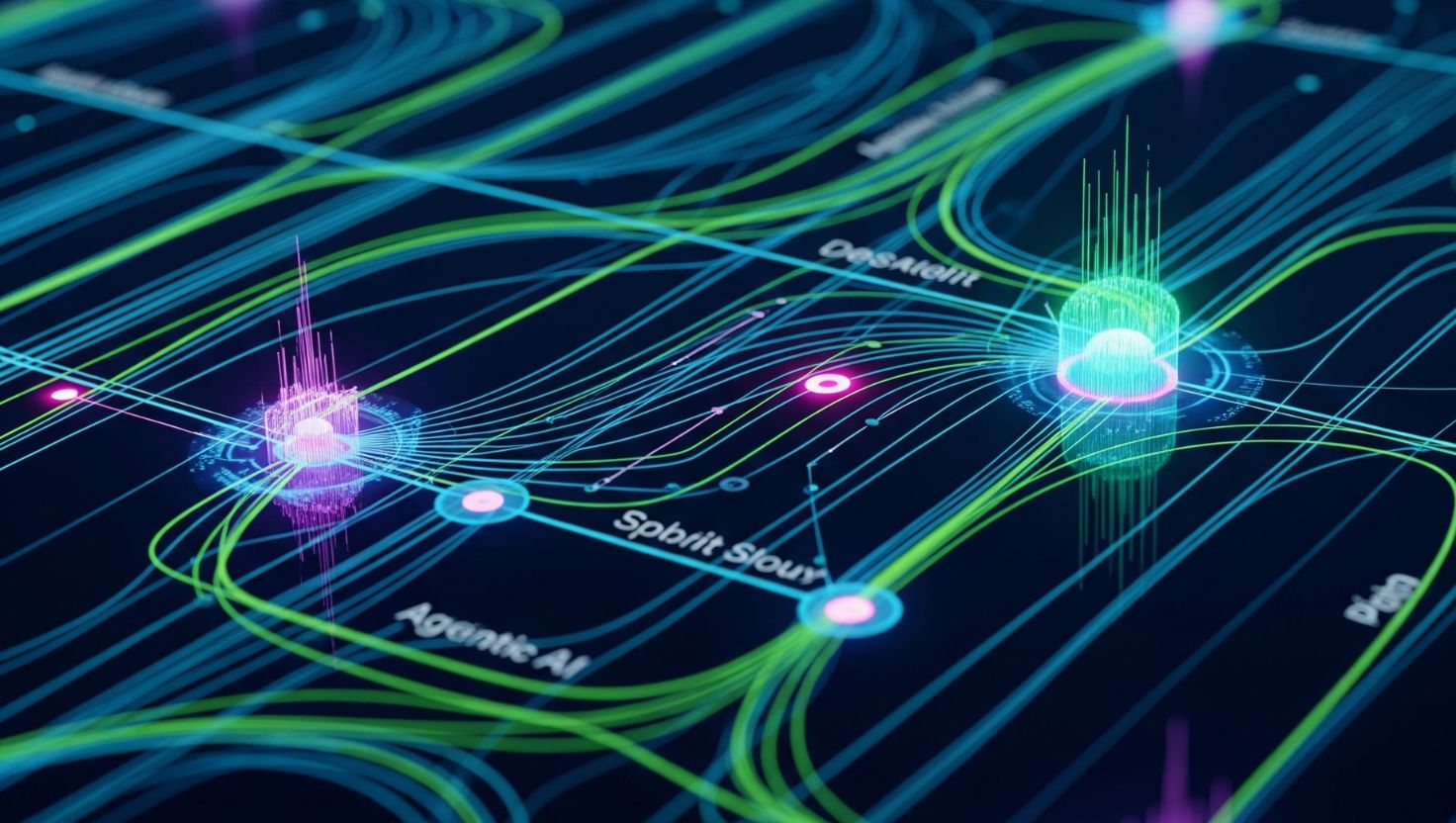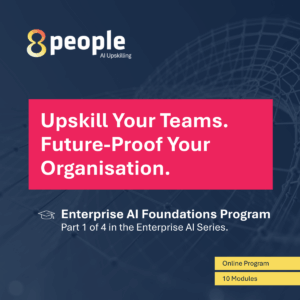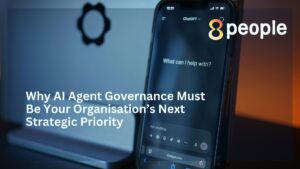Welcome to the new era of a technological revolution where AI systems actively think, plan and execute complex business processes with unprecedented autonomy and intelligence!
According to MIT’s Computer Science and Artificial Intelligence Laboratory [CSAIL] projects that by 2028, 33% of enterprise software applications will include agentic AI, up from less than 1% in 2024, while at least 15% of day-to-day work decisions will be made autonomously through agentic AI, up from zero percent today.
Let that sink in. These are not distant projections, this transformation is already underway.
Major technology companies including Google, Microsoft and OpenAI have invested heavily in software libraries and frameworks to support agentic functionality over the past 18 months. These applications are making the shift from knowledge-based tools to action-based systems that can independently execute complex workflows.
So, What Does that Mean for Enterprise?
While generative AI has captured headlines for its ability to create content, agentic AI operates on an entirely different level of sophistication and autonomy.
Harvard Business Review defines agentic AI as ”You can define agentic AI with one word: proactiveness. It refers to AI systems and models that can act autonomously to achieve goals without the need for constant human guidance. The agentic AI system understands what the goal or vision of the user is and the context to the problem they are trying to solve“. This fundamental shift from reactive to proactive AI represents a quantum leap in artificial intelligence capabilities.
Agentic AI systems have four key differences that set it apart from generative AI systems:
1. Agentic AI is focused on action and decision-making rather than content generation. While tools such as ChatGPT might help you write a marketing email, an agentic AI system would analyse your customer data, determine the optimal timing and messaging, personalise content for different segments, send emails, track responses and automatically adjust future campaigns based on performance metrics, all without human intervention.
2. Agentic AI systems don’t rely on human prompts or input. Instead, they’re designed to act independently to optimise specific goals or objectives.
3. These systems can independently carry out complex sequences of activities, searching databases, triggering workflows and coordinating multiple processes to complete sophisticated tasks. Imagine an AI agent that not only identifies a potential supply chain disruption but also automatically contacts alternative suppliers, negotiates terms, adjusts production schedules and updates stakeholders, all while you sleep.
4. Most importantly, agentic AI systems are dynamic and responsive and continuously adapt to their environment in real time and learn from their experiences. Agentic systems evolve and improve their performance through iterative refinement and self-learning capabilities.
The implications for enterprises are profound. Agentic AI fundamentally reimagines how work gets done!
The New Operating Model is Powered by Agentic AI
We are moving from automation to autonomy and Agentic AI will directly affect the following three areas of the enterprise:
- Operational Efficiency
- Workforce Optimisation
- Innovation Acceleration
Forbes defines agentic AI as “the new AI workforce,” highlighting that “for enterprises still focused on earlier waves of AI, the time to explore agentic AI is now.
Agentic AI enables new forms of value creation, from AI-powered services that operate autonomously to entirely new customer experiences that weren’t previously possible!
Real-World Applications of Agentic AI
There are many use cases for agentic AI across customer service, manufacturing, supply chain, sales, marketing and so on.
What makes these applications particularly powerful is their ability to work together in coordinated multi-agent systems. Rather than operating in isolation, agentic AI systems can collaborate to solve large-scale, interdependent challenges.
Let’s look at some examples:
The logistics and transportation sector is experiencing fundamental transformation through agentic AI systems that optimise routing, manage fleet operations and coordinate complex delivery networks. These systems can dynamically adjust routes based on traffic conditions, weather patterns and delivery priorities while automatically handling exceptions and customer communications. Companies implementing these solutions report significant improvements in delivery times, fuel efficiency and customer satisfaction.
In customer service, agentic AI customer service agents can understand customer intents, emotions and take independent steps to resolve queries and problems.
In supply chain for example, these agents can assess whether a customer delivery will be late, proactively inform the customer of the delay and automatically offer appropriate compensation. All this happens without human intervention!
In complex manufacturing setting, agentic AI can predict maintenance, monitor equipment performance, autonomously schedule maintenance interventions, order replacement parts and adjust production schedules to minimise disruptions.
Sales and marketing functions are being transformed through agentic AI systems that can qualify leads, handle objections and book meetings autonomously. Agentic AI liberates sales teams from time-consuming administrative tasks so they can focus on high-value relationship building. These systems can analyse customer behaviour patterns, predict purchasing intent and automatically initiate personalised engagement that nurture prospects through the sales funnel.
The Agentic AI Architecture
While leaders don’t need to become technical experts, understanding the fundamental architecture of agentic AI systems is crucial.
At its core, agentic AI relies on what industry experts call a “reasoning engine” that enables autonomous decision-making.
This reasoning engine serves as the central system that processes information and rests on three core principles:
1. Autonomous problem-solving capability which allows these systems to independently break down complex objectives, identify critical tasks and execute them without explicit human intervention. This capability positions agentic AI as a key enabler of end-to-end automation, moving beyond the limitations of traditional rule-based systems that require extensive programming for each scenario.
2. Adaptability and contextual awareness, ensuring that systems interpret actions and nuanced context. This allows them to adjust their actions dynamically based on evolving circumstances, which is a critical capability in today’s rapidly changing business environment.
3. Iterative refinement and self-learning capability. Unlike static AI systems, agentic AI continuously evaluates the outcomes of its actions, learns from errors and refines its approach over time.
To build your own enterprise AI Agentic architecture, leaders should follow the following three stage process:
1. Establish query intent and context. The system needs to capture user inputs or triggers, leverage natural language understanding to interpret semantics and intent. This stage ensures that the AI agent understands not just what needs to be done, but why it needs to be done and in what context.
2. Retrieval focuses on contextual data gathering and alignment. The system connects to multiple structured and unstructured data sources, including enterprise applications, external APIs and databases.
3. Generation and execution involves creating actionable outputs and implementing decisions. Agentic AI systems can execute actions directly, triggering workflows, updating systems and coordinating with other agents to complete complex tasks.
What makes this architecture particularly powerful for business applications is its ability to work with existing software tools and platforms. Agentic AI systems can interface with current enterprise software applications, search the web for information, collect and compile human feedback and leverage additional AI models as needed.
This compatibility means that enterprises don’t need to completely overhaul their technology infrastructure to benefit from agentic AI capabilities!
The multi-agent collaboration capability represents a significant advancement in enterprise AI architecture. Rather than deploying single-purpose AI systems, enterprises can create networks of specialised agents that work together to solve complex, interdependent challenges.
For senior leaders evaluating agentic AI initiatives, understanding this architecture helps inform critical decisions about vendor selection, internal capability development and change management strategies. The technology’s ability to work with existing systems while providing natural language interfaces means that implementation can be more gradual and less disruptive than traditional enterprise software deployments.
However, the architecture also introduces new considerations around governance, security and risk management. Because agentic AI systems can take autonomous actions across multiple systems and data sources, enterprises need robust frameworks for monitoring, controlling and auditing AI agent behaviour. This requires new approaches to AI governance that go beyond traditional software management practices.
Implementation of Agentic AI into your Enterprise
Successfully implementing agentic AI requires a strategic approach and enterprises must first identify specific business challenges where agentic AI can deliver the greatest impact.
We recommend that businesses integrate Agentic AI into their strategic planning to ensure enterprise goals are met through clearly defined objectives.
The most successful implementations start with pilot projects in controlled environments where the potential for both learning and value creation is high, while the risk of significant disruption is manageable.
Enterprise readiness assessment represents a critical early step that many leaders overlook. Agentic AI implementation requires more than technological capability, it also demands cultural readiness for autonomous decision-making, robust data governance frameworks and clear policies for human-AI collaboration.
Enterprises should evaluate their current AI maturity, data quality and accessibility, change management capabilities and risk tolerance before committing to large-scale agentic AI initiatives. Begin with an AI Readiness Survey from 8people, www.8people.io
While these systems operate autonomously, they require human oversight and continuous refinement.
Enterprises need to develop new roles and capabilities around AI agent management, including agent trainers, performance monitors and strategic coordinators who can optimise agent behaviour and ensure alignment with business objectives.
This represents a significant change management challenge that requires proactive planning and investment in workforce development.
Data strategy becomes even more critical with agentic AI than with traditional AI implementations. Because agentic systems need access to real-time, high-quality data across multiple business functions to make autonomous decisions, enterprises must ensure robust data integration, quality management and security protocols. The systems’ ability to act independently means that data errors or security vulnerabilities can have immediate and significant business impact!
Risk management and governance frameworks must evolve to address the unique challenges of autonomous AI systems. Traditional IT governance models, designed for human-controlled systems are insufficient for managing AI agents that can make independent decisions and take autonomous actions. Enterprises need new frameworks for monitoring agent behaviour ensuring compliance with regulatory requirements.
The new technology infrastructure requires additional computational resources, enhanced security frameworks and new integration capabilities. Enterprises should evaluate whether to build internal capabilities, partner with technology vendors or adopt hybrid approaches that combine internal development with external platforms.
Change management becomes particularly complex with agentic AI because these systems fundamentally alter how work gets done. Unlike traditional automation that typically replaces specific tasks, agentic AI can transform entire workflows and decision-making processes.
Senior leaders should recognise that agentic AI implementation is not a one-time project but an ongoing transformation that will continue to evolve as the technology matures. Successful enterprises build adaptive capabilities that can evolve with the technology, rather than rigid implementations that become obsolete quickly. This requires ongoing investment in learning, experimentation and capability development.
Navigating Challenges and Risks
While the potential of agentic AI is transformative, privacy and security represent perhaps the most significant challenges facing agentic AI implementation.
Unlike traditional AI systems that process data in controlled environments, agentic AI needs real-time access to multiple data sources across the enterprise to make autonomous decisions.
The complexity is compounded by the fact that most agentic AI systems operate in cloud environments rather than on-premises infrastructure. This means sensitive business data is transmitted back and forth between enterprise systems and cloud-based AI platforms, creating what experts describe as “muddied” data and privacy guarantees. Enterprises must implement robust encryption, access controls and data governance frameworks to mitigate these risks while enabling the data access that agentic AI systems require.
The question of human oversight and control becomes particularly complex with agentic AI systems. Traditional approaches to AI governance, which assume human review and approval of AI recommendations, become impractical when systems are designed to operate autonomously. Enterprises must determine the appropriate level of human involvement for different types of decisions and business contexts.
The regulatory landscape for agentic AI remains uncertain and evolving, creating compliance challenges for enterprises operating in regulated industries. Current AI regulations were largely designed for human-controlled AI systems and may not adequately address the unique characteristics of autonomous AI agents.
Bias and fairness issues that have plagued other AI systems are likely to be amplified in agentic AI implementations. Because these systems can make autonomous decisions that directly affect customers and employees, biased AI behaviour can have immediate and significant impact. Enterprises must implement robust bias detection and mitigation strategies throughout the AI agent lifecycle.
Despite these challenges, it’s important to recognise that many of these issues can be effectively managed through thoughtful planning, robust governance frameworks and proactive risk management.
The Future Landscape
The next wave of agentic AI development will likely focus on enhanced collaboration capabilities, both between AI agents and between AI systems and human workers. We are moving toward what researchers describe as “multi-agent ecosystems” where specialised AI agents work together seamlessly to solve complex, interdependent challenges. These systems will be able to coordinate tasks dynamically, share insights across functional boundaries and adapt their collaboration patterns based on changing business requirements.
Industry experts predict that by 2028, we’ll see agentic AI systems that can operate across entire value chains, from customer acquisition and product development to manufacturing and post-sale support. These integrated systems will provide unprecedented visibility and control over business operations while enabling new forms of value creation that aren’t possible with current technology.
We are also likely to see the emergence of industry-specific agentic AI platforms that understand the unique requirements, regulations and best practices of particular sectors. Healthcare agentic AI will incorporate medical knowledge and regulatory compliance requirements, while financial services agents will understand risk management frameworks and regulatory reporting obligations.
The workforce implications of widespread agentic AI adoption will also evolve and will likely create new categories of jobs focused on AI agent management, strategy and optimisation.
The economic impact of agentic AI will likely extend beyond individual enterprises to reshape entire industries and market structures. We may see the emergence of new business models based on AI agent capabilities, changes in competitive dynamics as operational costs decrease and shifts in value creation as AI agents enable new forms of products and services.
Taking Action & Your Next Steps in the Agentic AI Journey
The evidence is clear – Agentic AI represents a fundamental shift in how businesses will operate, compete and create value in the coming decade.
If you are interested in starting your enterprise transition towards this future model, reach out to www.8people.io
Consider subscribing to our Newsletter AI Intelligent Enterprise




